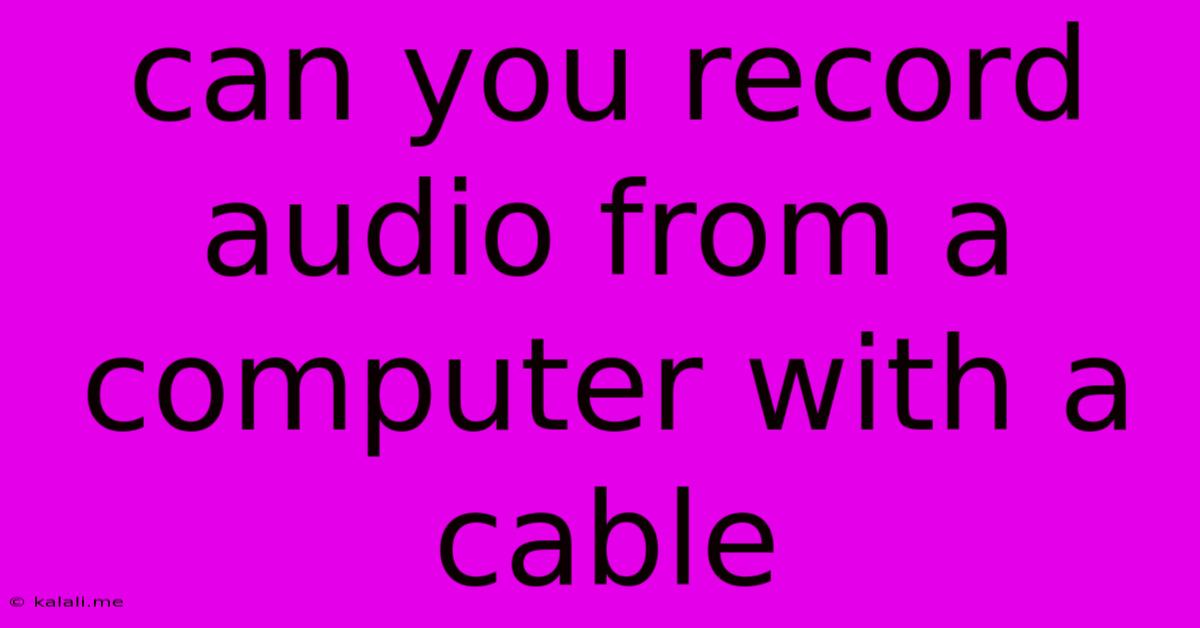Can You Record Audio From A Computer With A Cable
Kalali
Jun 04, 2025 · 3 min read

Table of Contents
Can You Record Audio from a Computer with a Cable? Yes, Here's How!
Meta Description: Learn how to record audio from your computer using a cable. This guide explores various connection methods, including 3.5mm jacks, USB audio interfaces, and more, providing solutions for different audio sources and recording needs.
Recording audio from your computer might seem straightforward, but the best method depends on your audio source and desired quality. Simply plugging in your headphones won't cut it for high-quality recordings. This article explores several ways to record audio from your computer using a cable, ensuring you capture clean, crisp audio every time.
Understanding Your Audio Source
Before diving into connection methods, it's crucial to identify your audio source. This will dictate the type of cable and potentially additional equipment you'll need. Common audio sources include:
- Line-level audio: This is the standard output from your computer's sound card. It's suitable for recording pre-mixed audio, like music playback.
- Instrument-level audio: This is a higher-output signal, typically from instruments like guitars or keyboards. It requires a dedicated audio interface to avoid distortion.
- Microphone-level audio: This is a low-level signal requiring amplification before recording. Again, an audio interface is usually necessary for optimal results.
Recording Methods Using Cables
Several methods exist for connecting and capturing audio from your computer using cables:
1. Using a 3.5mm Cable (Line-Level Audio):
This is the simplest method for capturing line-level audio. You'll need a 3.5mm (1/8-inch) stereo cable, connecting the line output of your computer to the line input of your recording device (e.g., a mixer, recorder, or audio interface). However, note that the audio quality might be lower compared to other methods.
- Limitations: Prone to noise and interference; unsuitable for low-level signals like microphones. Direct connection to a computer's line-in might not always be available.
2. Employing a USB Audio Interface:
For higher quality and versatility, a USB audio interface is highly recommended. This device provides multiple inputs and outputs, often including XLR microphone inputs, instrument inputs, and line inputs. It also offers better signal-to-noise ratio compared to using the computer's built-in sound card.
- Benefits: Superior audio quality, lower noise, multiple input options (XLR, 1/4-inch, etc.), and often includes headphone monitoring.
- Considerations: Requires a computer with a free USB port and suitable software for recording.
3. Utilizing a Digital Audio Interface (e.g., Thunderbolt or ADAT):
For professional recording setups, digital audio interfaces offer even higher fidelity and more advanced features. These interfaces use digital connections like Thunderbolt or ADAT, allowing for higher sample rates and bit depths for exceptional audio quality.
- Advantages: Highest fidelity, minimal audio degradation, numerous input/output options for complex setups.
- Disadvantages: More expensive, requires compatible software and hardware.
4. Connecting Directly to a DAW (Digital Audio Workstation):
Some Digital Audio Workstations (DAWs) have built-in audio interfaces, eliminating the need for an external device. However, this depends on the DAW's capabilities and often requires specific hardware or software configurations.
- Benefits: Streamlined workflow, no additional hardware required (in some cases).
- Limitations: Limited input options compared to dedicated audio interfaces; DAW-specific compatibility.
Software Considerations
Regardless of the chosen method, you'll need recording software (a DAW) to capture the audio. Popular options include Audacity (free and open-source), GarageBand (macOS), and professional software such as Ableton Live, Logic Pro X, Pro Tools, and Cubase.
Troubleshooting Common Issues
- No sound: Check all cable connections, ensure your input device is selected correctly in your DAW and operating system settings.
- Low volume: Adjust the input gain on your audio interface or recording device.
- Noise/hiss: Ground loops can cause this. Try different outlets or use a ground lift adapter.
By understanding your audio source and choosing the appropriate cabling and recording method, you can successfully record high-quality audio from your computer. Remember to always select the correct input and adjust settings for optimal results.
Latest Posts
Latest Posts
-
Main Water Shutoff Valve From Well
Jun 06, 2025
-
How To Say Slang In Spanish
Jun 06, 2025
-
How Many Counts Does A Quarter Note Get
Jun 06, 2025
-
Does Spraying The Roof Cool House
Jun 06, 2025
-
Vim Create New Directory From Directory Listing
Jun 06, 2025
Related Post
Thank you for visiting our website which covers about Can You Record Audio From A Computer With A Cable . We hope the information provided has been useful to you. Feel free to contact us if you have any questions or need further assistance. See you next time and don't miss to bookmark.